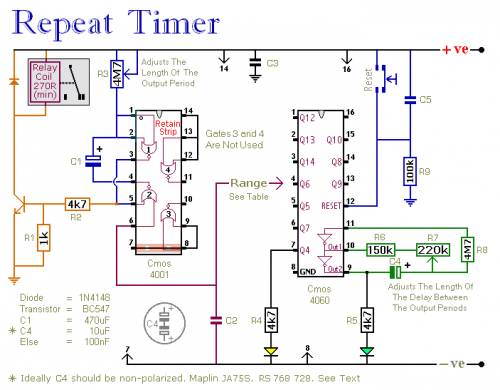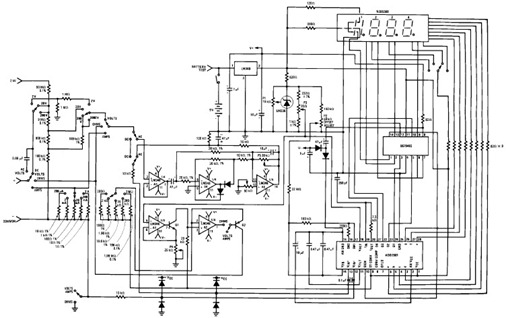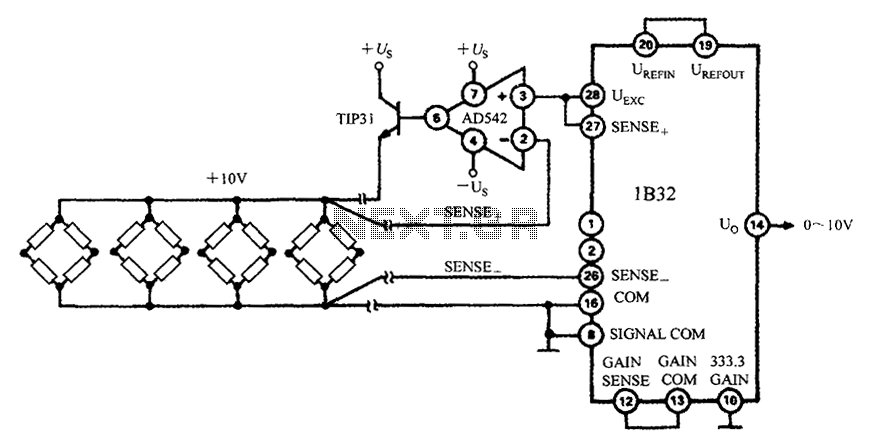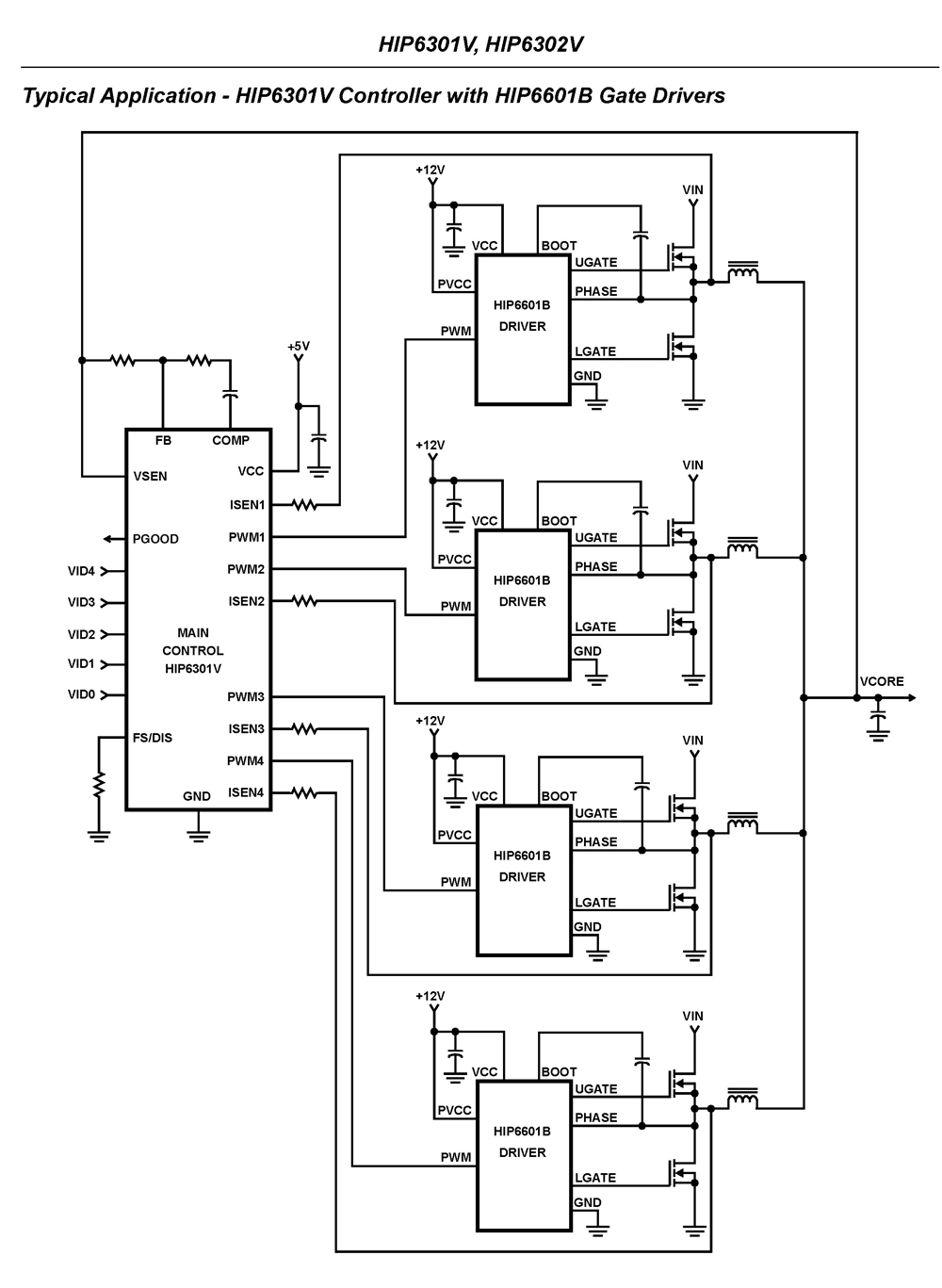
multi purpose flip flop timer
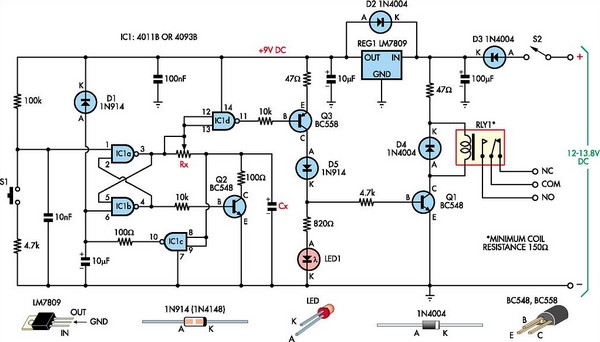
This timing circuit is designed to time one-shot events ranging from a few seconds to several hours. In standby mode, where RLY1 and LED1 are off, the power consumption is minimal. The core component of the circuit is a low-cost CMOS 4011 quad NAND gate, with IC1a and IC1b configured as a standard Set/Reset flip-flop. Briefly pressing switch S1 initiates the timing sequence by pulling pin 1 of IC1a low, which causes pin 3 to go high. This triggers two actions: first, capacitor Cx begins charging through potentiometer Rx; second, pin 11 of IC1d goes low, activating transistors Q3 and Q1, which turns on both LED1 and relay RLY1. These remain on until Cx is charged to approximately 70% of Vcc. At this point, pins 8 and 9 of IC1c are pulled high, resulting in pin 10 output going low, which resets the flip-flop by applying a low signal to pin 6 of IC1b. Consequently, pin 3 of IC1a goes low, turning off LED1 and RLY1, marking the end of the timing period. Simultaneously, pin 4 of the flip-flop goes high, activating transistor Q2 as long as the flip-flop is held in reset, ensuring that Cx discharges and the circuit is prepared for the next activation of S1. Diode D1, along with a 10 µF capacitor, resets the flip-flop upon initial power application, keeping LED1 and RLY1 off until S1 is pressed. Diode D4 is included to protect Q1 from back-EMF generated when the relay switches off. Selecting appropriate values for Cx and Rx for a specific delay is straightforward, following the formula T = 1.24 x Rx x Cx, where T is the delay time in seconds. For instance, to achieve a 10-second delay using a 100 µF capacitor for Cx, an 82 kΩ resistor would be the closest value for Rx. Either a fixed resistor or a potentiometer can be used for Rx, with the latter allowing for adjustable time delays. The value of Rx should not exceed a few megohms. The circuit is powered by any 12V DC source, which is fed into a 3-terminal regulator (REG1) to produce a 9V rail for the circuitry, while the relay circuit operates from the 12V rail. Diode D3 safeguards the circuit against incorrect supply polarity.
The circuit operates effectively by utilizing a combination of a CMOS NAND gate and a set/reset flip-flop configuration, allowing for precise timing control. The activation of the timing sequence through switch S1 initiates a charge cycle for capacitor Cx, which is critical in determining the timing duration. The use of a potentiometer for Rx provides flexibility in adjusting the timing delay, accommodating different application requirements.
The design ensures low power consumption in standby mode, making it suitable for battery-operated devices or applications where power efficiency is crucial. The protection mechanisms, including diodes D1 and D4, enhance the reliability of the circuit by preventing damage from voltage spikes and ensuring correct operation during power-up.
The choice of components, such as the CMOS 4011 and transistors, reflects a balance between cost and performance, making this timing circuit an economical solution for various timing applications. The straightforward formula for calculating the timing delay simplifies the design process for users, allowing for quick adjustments to meet specific timing needs. Overall, this circuit provides a robust solution for timing applications with minimal power consumption and user-friendly adjustability.This particular timing circuit can be used to time one-shot events from a few seconds to a few hours. And in standby mode (ie, with RLY1 and LED1 off), its power consumption is very low. The heart of this circuit is a low-cost CMOS 4011 quad NAND gate, with IC1a & IC1b configured as a standard Set/Reset flip-flop.
Briefly pressing switch S1 to sta rt the timing sequence pulls pin 1 of IC1a low and, as a result, pin 3 switches high. Two things happen while pin 3 is high: capacitor Cx begins charging via potentiometer Rx; and (2) pin 11 of IC1d will be low, which means that transistors Q3 and Q1 are both on. As a result, both LED 1 and relay RLY1 are also on. RLY1 and LED 1 remain on until Cx has been charged up to about 70% of Vcc (ie, the supply rail). At this point, pins 8 & 9 of IC1c are pulled high and so its pin 10 output goes low and resets the flip-flop by applying a low to pin 6 of IC1b.
This causes pin 3 of IC1a to go low and so LED1 and RLY1 switch off and the timing period ends. At the same time, pin 4 of the flip-flop goes high and this turns on transistor Q2 while ever the flip-flop is held reset. This ensures that Cx is discharged, so that the circuit is ready the next time S1 is pressed. Diode D1 and its associated 10 µF capacitor reset the flip-flop when power is first applied, so that LED1 and RLY1 remain off until S1 is pressed.
D4 is included to protect Q1 against the back-EMF that`s generated when the relay switches off. Choosing appropriate values for Cx & Rx for a given time delay is straightforward. The formula is T = 1. 24 x Rx x Cx, where T is the delay time in seconds. As an example, let`s assume that we require a time delay of 10s using a value of 100 µF for Cx. Now we just need to calculate the value of Rx as follows: In this case, an 82kO resistor would be the closest value. You can use either a fixed resistor for Rx or you can use a potentiometer (or trimpot) which can be adjusted to give the required time delay.
Note that the value of Rx should not be any more than a few megohms. Power for the circuit can be derived from any 12V DC source. This is then fed to 3-terminal regulator REG1 to derive a 9V rail to power the circuitry. The exception here is the relay circuit, which is powered from the 12V rail. Diode D3 protects the circuit against incorrect supply polarity. 🔗 External reference
The circuit operates effectively by utilizing a combination of a CMOS NAND gate and a set/reset flip-flop configuration, allowing for precise timing control. The activation of the timing sequence through switch S1 initiates a charge cycle for capacitor Cx, which is critical in determining the timing duration. The use of a potentiometer for Rx provides flexibility in adjusting the timing delay, accommodating different application requirements.
The design ensures low power consumption in standby mode, making it suitable for battery-operated devices or applications where power efficiency is crucial. The protection mechanisms, including diodes D1 and D4, enhance the reliability of the circuit by preventing damage from voltage spikes and ensuring correct operation during power-up.
The choice of components, such as the CMOS 4011 and transistors, reflects a balance between cost and performance, making this timing circuit an economical solution for various timing applications. The straightforward formula for calculating the timing delay simplifies the design process for users, allowing for quick adjustments to meet specific timing needs. Overall, this circuit provides a robust solution for timing applications with minimal power consumption and user-friendly adjustability.This particular timing circuit can be used to time one-shot events from a few seconds to a few hours. And in standby mode (ie, with RLY1 and LED1 off), its power consumption is very low. The heart of this circuit is a low-cost CMOS 4011 quad NAND gate, with IC1a & IC1b configured as a standard Set/Reset flip-flop.
Briefly pressing switch S1 to sta rt the timing sequence pulls pin 1 of IC1a low and, as a result, pin 3 switches high. Two things happen while pin 3 is high: capacitor Cx begins charging via potentiometer Rx; and (2) pin 11 of IC1d will be low, which means that transistors Q3 and Q1 are both on. As a result, both LED 1 and relay RLY1 are also on. RLY1 and LED 1 remain on until Cx has been charged up to about 70% of Vcc (ie, the supply rail). At this point, pins 8 & 9 of IC1c are pulled high and so its pin 10 output goes low and resets the flip-flop by applying a low to pin 6 of IC1b.
This causes pin 3 of IC1a to go low and so LED1 and RLY1 switch off and the timing period ends. At the same time, pin 4 of the flip-flop goes high and this turns on transistor Q2 while ever the flip-flop is held reset. This ensures that Cx is discharged, so that the circuit is ready the next time S1 is pressed. Diode D1 and its associated 10 µF capacitor reset the flip-flop when power is first applied, so that LED1 and RLY1 remain off until S1 is pressed.
D4 is included to protect Q1 against the back-EMF that`s generated when the relay switches off. Choosing appropriate values for Cx & Rx for a given time delay is straightforward. The formula is T = 1. 24 x Rx x Cx, where T is the delay time in seconds. As an example, let`s assume that we require a time delay of 10s using a value of 100 µF for Cx. Now we just need to calculate the value of Rx as follows: In this case, an 82kO resistor would be the closest value. You can use either a fixed resistor for Rx or you can use a potentiometer (or trimpot) which can be adjusted to give the required time delay.
Note that the value of Rx should not be any more than a few megohms. Power for the circuit can be derived from any 12V DC source. This is then fed to 3-terminal regulator REG1 to derive a 9V rail to power the circuitry. The exception here is the relay circuit, which is powered from the 12V rail. Diode D3 protects the circuit against incorrect supply polarity. 🔗 External reference
